3D Printed Supercapacitor Exploiting PEDOT-Based Resin and Polymer Gel Electrolyte
Abstract
1. Introduction
2. Materials and Methods
2.1. PEGDA:PEDOT Resin Preparation
2.2. Device Design
2.3. D Printing and Device Assembly
2.4. Electrochemical Measurements
3. Results
3.1. PEGDA:PEDOT Resin Characterization
3.2. Device Performance
4. Conclusions
Supplementary Materials
Author Contributions
Funding
Institutional Review Board Statement
Data Availability Statement
Conflicts of Interest
References
- Wu, J.; Wang, Y.; Deng, D.; Bai, Y.; Liu, M.; Zhao, X.; Xiong, X.; Lei, Y. Low-Temperature Resistant Gel Polymer Electrolytes for Zinc–Air Batteries. J. Mater. Chem. A Mater. 2022, 10, 19304–19319. [Google Scholar] [CrossRef]
- Amponsah Kyeremateng, N.; Brousse, T.; Pech, D. Microsupercapacitors as Miniaturized Energy-Storage Components for on-Chip Electronics. Nat. Publ. Group 2016, 12, 7–15. [Google Scholar] [CrossRef]
- Speranza, R.; Zaccagnini, P.; Sacco, A.; Lamberti, A. High-Voltage Energy Harvesting and Storage System for Internet of Things Indoor Application. Sol. RRL 2022, 6, 2200245. [Google Scholar] [CrossRef]
- Wang, Q.; Feng, Q.; Lei, Y.; Tang, S.; Xu, L.; Xiong, Y.; Fang, G.; Wang, Y.; Yang, P.; Liu, J.; et al. Quasi-Solid-State Zn-Air Batteries with an Atomically Dispersed Cobalt Electrocatalyst and Organohydrogel Electrolyte. Nat. Commun. 2022, 13, 3689. [Google Scholar] [CrossRef] [PubMed]
- Reina, M.; Scalia, A.; Auxilia, G.; Fontana, M.; Bella, F.; Ferrero, S.; Lamberti, A. Boosting Electric Double Layer Capacitance in Laser-Induced Graphene-Based Supercapacitors. Adv. Sustain. Syst. 2022, 6, 2100228. [Google Scholar] [CrossRef]
- Li, L.; Zhang, J.; Peng, Z.; Li, Y.; Gao, C.; Ji, Y.; Ye, R.; Dong Kim, N.; Zhong, Q.; Yang, Y.; et al. High-Performance Pseudocapacitive Microsupercapacitors from Laser-Induced Graphene. Adv. Mater. 2016, 28, 838–845. [Google Scholar] [CrossRef] [PubMed]
- Wang, K.; Wang, S.; Liu, J.; Guo, Y.; Mao, F.; Wu, H.; Zhang, Q. Fe-Based Coordination Polymers as Battery-Type Electrodes in Semi-Solid-State Battery-Supercapacitor Hybrid Devices. ACS Appl. Mater. Interfaces 2021, 13, 15315–15323. [Google Scholar] [CrossRef]
- Zuo, W.; Li, R.; Zhou, C.; Li, Y.; Xia, J.; Liu, J.; Zuo, W.H.; Xia, J.L.; Liu, J.P.; Li, R.Z.; et al. Battery-Supercapacitor Hybrid Devices: Recent Progress and Future Prospects. Adv. Sci. 2017, 4, 1600539. [Google Scholar] [CrossRef]
- Poonam; Sharma, K.; Arora, A.; Tripathi, S.K. Review of Supercapacitors: Materials and Devices. J. Energy Storage 2019, 21, 801–825. [Google Scholar] [CrossRef]
- Kim, D.; Shin, G.; Kang, Y.J.; Kim, W.; Ha, J.S. Fabrication of a Stretchable Solid-State Micro-Supercapacitor Array. ACS Nano 2013, 7, 7975–7982. [Google Scholar] [CrossRef]
- Bu, F.; Zhou, W.; Xu, Y.; Du, Y.; Guan, C.; Huang, W. Recent Developments of Advanced Micro-Supercapacitors: Design, Fabrication and Applications. npj Flex. Electron. 2020, 4, 31. [Google Scholar] [CrossRef]
- Zhang, W.; Liu, H.; Zhang, X.; Li, X.; Zhang, G.; Cao, P.; Zhang, W.; Cao, P.; Liu, H.; Zhang, X.; et al. 3D Printed Micro-Electrochemical Energy Storage Devices: From Design to Integration. Adv. Funct. Mater. 2021, 31, 2104909. [Google Scholar] [CrossRef]
- Wang, Y.; Yang, Q.; Zhao, Y.; Du, S.; Zhi, C.; Electrodes Wang, F.Y.; Zhao, Y.; Du, S.; Wang, Y.; Yang, Q.; et al. Recent Advances in Electrode Fabrication for Flexible Energy-Storage Devices. Adv. Mater. Technol. 2019, 4, 1900083. [Google Scholar] [CrossRef]
- Park, S.H.; Goodall, G.; Kim, W.S. Perspective on 3D-Designed Micro-Supercapacitors. Mater. Des. 2020, 193, 108797. [Google Scholar] [CrossRef]
- Chu, T.; Park, S.; Fu, K. 3D Printing-Enabled Advanced Electrode Architecture Design. Carbon Energy 2021, 3, 424–439. [Google Scholar] [CrossRef]
- Jha, S.; Velhal, M.; Stewart, W.; Amin, V.; Wang, E.; Liang, H. Additively Manufactured Electrodes for Supercapacitors: A Review. Appl. Mater. Today 2022, 26, 101220. [Google Scholar] [CrossRef]
- Foo, C.Y.; Lim, H.N.; Mahdi, M.A.; Wahid, M.H.; Huang, N.M. Three-Dimensional Printed Electrode and Its Novel Applications in Electronic Devices. Sci. Rep. 2018, 8, 7399. [Google Scholar] [CrossRef]
- Jiang, Y.; Cheng, M.; Shahbazian-Yassar, R.; Pan, Y.; Jiang, Y.; Cheng, M.; Shahbazian-Yassar, R.; Pan, Y. Direct Ink Writing of Wearable Thermoresponsive Supercapacitors with RGO/CNT Composite Electrodes. Adv. Mater. Technol. 2019, 4, 1900691. [Google Scholar] [CrossRef]
- Zhang, C.; McKeon, L.; Kremer, M.P.; Park, S.H.; Ronan, O.; Seral-Ascaso, A.; Barwich, S.; Coileáin, C.; McEvoy, N.; Nerl, H.C.; et al. Additive-Free MXene Inks and Direct Printing of Micro-Supercapacitors. Nat. Commun. 2019, 10, 1795. [Google Scholar] [CrossRef]
- Orangi, J.; Hamade, F.; Davis, V.A.; Beidaghi, M. 3D Printing of Additive-Free 2D Ti 3 C 2 T x (MXene) Ink for Fabrication of Micro-Supercapacitors with Ultra-High Energy Densities. ACS Nano 2020, 14, 640–650. [Google Scholar] [CrossRef]
- Sajedi-Moghaddam, A.; Rahmanian, E.; Naseri, N. Inkjet-Printing Technology for Supercapacitor Application: Current State and Perspectives. ACS Appl. Mater. Interfaces 2020, 12, 34487–34504. [Google Scholar] [CrossRef]
- Divakaran, N.; Das, J.P.; PV, A.K.; Mohanty, S.; Ramadoss, A.; Nayak, S.K. Comprehensive Review on Various Additive Manufacturing Techniques and Its Implementation in Electronic Devices. J. Manuf. Syst. 2022, 62, 477–502. [Google Scholar] [CrossRef]
- Xu, X.; Tan, Y.H.; Ding, J.; Guan, C. 3D Printing of Next-Generation Electrochemical Energy Storage Devices: From Multiscale to Multimaterial. Energy Environ. Mater. 2022, 5, 427–438. [Google Scholar] [CrossRef]
- Egorov, V.; Gulzar, U.; Zhang, Y.; Breen, S.; O’Dwyer, C. Evolution of 3D Printing Methods and Materials for Electrochemical Energy Storage. Adv. Mater. 2020, 32, 2000556. [Google Scholar] [CrossRef]
- Rezaei, B.; Hansen, T.W.; Keller, S.S. Stereolithography-Derived Three-Dimensional Pyrolytic Carbon/Mn 3 O 4 Nanostructures for Free-Standing Hybrid Supercapacitor Electrodes. ACS Appl. Nano Mater. 2022, 5, 1808–1819. [Google Scholar] [CrossRef]
- Chang, P.; Mei, H.; Tan, Y.; Zhao, Y.; Huang, W.; Cheng, L. A 3D-Printed Stretchable Structural Supercapacitor with Active Stretchability/Flexibility and Remarkable Volumetric Capacitance. J. Mater. Chem. A Mater. 2020, 8, 13646–13658. [Google Scholar] [CrossRef]
- Xue, J.; Gao, L.; Hu, X.; Cao, K.; Zhou, W.; Wang, W.; Lu, Y. Stereolithographic 3D Printing-Based Hierarchically Cellular Lattices for High-Performance Quasi-Solid Supercapacitor. Nanomicro Lett. 2019, 11, 46. [Google Scholar] [CrossRef]
- Khoo, Z.X.; Teoh, J.E.M.; Liu, Y.; Chua, C.K.; Yang, S.; An, J.; Leong, K.F.; Yeong, W.Y. 3D Printing of Smart Materials: A Review on Recent Progresses in 4D Printing. Virtual Phys. Prototyp. 2015, 10, 103–122. [Google Scholar] [CrossRef]
- Chaparro-Garnica, C.Y.; Bailón-García, E.; Lozano-Castelló, D.; Bueno-López, A. Design and Fabrication of Integral Carbon Monoliths Combining 3D Printing and Sol–Gel Polymerization: Effects of the Channel Morphology on the CO-PROX Reaction. Catal. Sci. Technol. 2021, 11, 6490–6497. [Google Scholar] [CrossRef]
- Da, Y.; Liu, J.; Zhou, L.; Zhu, X.; Chen, X.; Fu, L. Engineering 2D Architectures toward High-Performance Micro-Supercapacitors. Adv. Mater. 2019, 31, e1802793. [Google Scholar] [CrossRef]
- Borenstein, A.; Hanna, O.; Attias, R.; Luski, S.; Brousse, T.; Aurbach, D. Carbon-Based Composite Materials for Supercapacitor Electrodes: A Review. J. Mater. Chem. A Mater. 2017, 5, 12653–12672. [Google Scholar] [CrossRef]
- Kumar, S.; Saeed, G.; Zhu, L.; Hui, K.N.; Kim, N.H.; Lee, J.H. 0D to 3D Carbon-Based Networks Combined with Pseudocapacitive Electrode Material for High Energy Density Supercapacitor: A Review. Chem. Eng. J. 2021, 403, 126352. [Google Scholar] [CrossRef]
- Ambade, R.B.; Ambade, S.B.; Salunkhe, R.R.; Malgras, V.; Jin, S.H.; Yamauchi, Y.; Lee, S.H. Flexible-Wire Shaped All-Solid-State Supercapacitors Based on Facile Electropolymerization of Polythiophene with Ultra-High Energy Density. J. Mater. Chem. A Mater. 2016, 4, 7406–7415. [Google Scholar] [CrossRef]
- Eftekhari, A.; Li, L.; Yang, Y. Polyaniline Supercapacitors. J. Power Sources 2017, 347, 86–107. [Google Scholar] [CrossRef]
- Park, H.; Wook Kim, J.; Yeong Hong, S.; Lee, G.; Sik Kim, D.; hyun Oh, J.; Woo Jin, S.; Ra Jeong, Y.; Yun Oh, S.; Yeong Yun, J.; et al. Microporous Polypyrrole-Coated Graphene Foam for High-Performance Multifunctional Sensors and Flexible Supercapacitors. Adv. Funct. Mater. 2018, 28, 1707013. [Google Scholar] [CrossRef]
- Shown, I.; Ganguly, A.; Chen, L.C.; Chen, K.H. Conducting Polymer-Based Flexible Supercapacitor. Energy Sci. Eng. 2015, 3, 2–26. [Google Scholar] [CrossRef]
- Yang, J.; Cao, Q.; Tang, X.; Du, J.; Yu, T.; Xu, X.; Cai, D.; Guan, C.; Huang, W. 3D-Printed Highly Stretchable Conducting Polymer Electrodes for Flexible Supercapacitors. J. Mater. Chem. A 2021, 9, 19649–19658. [Google Scholar] [CrossRef]
- Wang, Z.; Zhang, Q.; Long, S.; Luo, Y.; Yu, P.; Tan, Z.; Bai, J.; Qu, B.; Yang, Y.; Shi, J.; et al. Three-Dimensional Printing of Polyaniline/Reduced Graphene Oxide Composite for High-Performance Planar Supercapacitor. ACS Appl. Mater. Interfaces 2018, 10, 10437–10444. [Google Scholar] [CrossRef]
- Gulzar, U.; Glynn, C.; O’Dwyer, C. Additive Manufacturing for Energy Storage: Methods, Designs and Material Selection for Customizable 3D Printed Batteries and Supercapacitors. Curr. Opin. Electrochem. 2020, 20, 46–53. [Google Scholar] [CrossRef]
- Salve, M.; Mandal, A.; Amreen, K.; Pattnaik, P.K.; Goel, S. Greenly Synthesized Silver Nanoparticles for Supercapacitor and Electrochemical Sensing Applications in a 3D Printed Microfluidic Platform. Microchem. J. 2020, 157, 104973. [Google Scholar] [CrossRef]
- Guo, B.; Liang, G.; Yu, S.; Wang, Y.; Zhi, C.; Bai, J. 3D Printing of Reduced Graphene Oxide Aerogels for Energy Storage Devices: A Paradigm from Materials and Technologies to Applications. Energy Storage Mater. 2021, 39, 146–165. [Google Scholar] [CrossRef]
- Chen, H.W.; Li, C. PEDOT: Fundamentals and Its Nanocomposites for Energy Storage. Chin. J. Polym. Sci. 2019, 38, 435–448. [Google Scholar] [CrossRef]
- Khasim, S.; Pasha, A.; Lakshmi, M.; Chellasamy, P.; Kadarkarai, M.; Darwish, A.A.A.; Hamdalla, T.A.; Al-Ghamdi, S.A.; Alfadhli, S. Post Treated PEDOT-PSS Films with Excellent Conductivity and Optical Properties as Multifunctional Flexible Electrodes for Possible Optoelectronic and Energy Storage Applications. Opt. Mater. 2022, 125, 112109. [Google Scholar] [CrossRef]
- Wang, H.; Diao, Y.; Lu, Y.; Yang, H.; Zhou, Q.; Chrulski, K.; D’Arcy, J.M. Energy Storing Bricks for Stationary PEDOT Supercapacitors. Nat. Commun. 2020, 11, 3882. [Google Scholar] [CrossRef]
- Chang, Z.; Huang, A.; An, X.; Qian, X. Design and Fabrication of High Performance Supercapacitor with Cellulosic Paper Electrode and Plant-Derived Redox Active Molecules. Carbohydr. Polym. 2020, 244, 116442. [Google Scholar] [CrossRef] [PubMed]
- Tai, C.; Peng, J.F.; Liu, J.F.; Jiang, G.B.; Zou, H. Determination of Hydroxyl Radicals in Advanced Oxidation Processes with Dimethyl Sulfoxide Trapping and Liquid Chromatography. Anal. Chim. Acta 2004, 527, 73–80. [Google Scholar] [CrossRef]
- Sappia, L.D.; Pascual, B.S.; Azzaroni, O.; Marmisollé, W. PEDOT-Based Stackable Paper Electrodes for Metal-Free Supercapacitors. ACS Appl. Energy Mater 2021, 4, 9283–9293. [Google Scholar] [CrossRef]
- Dong, L.; Xu, C.; Li, Y.; Pan, Z.; Liang, G.; Zhou, E.; Kang, F.; Yang Dong, Q.-H.L.; Xu, C.; Pan, Z.; et al. Breathable and Wearable Energy Storage Based on Highly Flexible Paper Electrodes. Adv. Mater. 2016, 28, 9313–9319. [Google Scholar] [CrossRef] [PubMed]
- Scordo, G.; Bertana, V.; Scaltrito, L.; Ferrero, S.; Cocuzza, M.; Marasso, S.L.; Romano, S.; Sesana, R.; Catania, F.; Pirri, C.F. A Novel Highly Electrically Conductive Composite Resin for Stereolithography. Mater. Today Commun. 2019, 19, 12–17. [Google Scholar] [CrossRef]
- Bertana, V.; De Pasquale, G.; Ferrero, S.; Scaltrito, L.; Catania, F.; Nicosia, C.; Marasso, S.L.; Cocuzza, M.; Perrucci, F. 3D Printing with the Commercial UV-Curable Standard Blend Resin: Optimized Process Parameters towards the Fabrication of Tiny Functional Parts. Polymers 2019, 11, 292. [Google Scholar] [CrossRef]
- Bertana, V.; Scordo, G.; Parmeggiani, M.; Scaltrito, L.; Ferrero, S.; Gomez, M.G.; Cocuzza, M.; Vurro, D.; D’Angelo, P.; Iannotta, S.; et al. Rapid Prototyping of 3D Organic Electrochemical Transistors by Composite Photocurable Resin. Sci. Rep. 2020, 10, 13335. [Google Scholar] [CrossRef] [PubMed]
- Li, M.; Zhou, S.; Cheng, L.; Mo, F.; Chen, L.; Yu, S.; Wei, J.; Li, M.; Zhou, S.; Cheng, L.; et al. 3D Printed Supercapacitor: Techniques, Materials, Designs, and Applications. Adv. Funct. Mater. 2022, 33, 2208034. [Google Scholar] [CrossRef]
- Shen, K.; Ding, J.; Yang, S.; Shen, K.; Ding, J.W.; Yang, S.B. 3D Printing Quasi-Solid-State Asymmetric Micro-Supercapacitors with Ultrahigh Areal Energy Density. Adv. Energy Mater. 2018, 8, 1800408. [Google Scholar] [CrossRef]
- Li, W.; Li, Y.; Su, M.; An, B.; Liu, J.; Su, D.; Li, L.; Li, F.; Song, Y. Printing Assembly and Structural Regulation of Graphene towards Three-Dimensional Flexible Micro-Supercapacitors. J. Mater. Chem. A 2017, 5, 16281–16288. [Google Scholar] [CrossRef]
- Scordo, G.; Bertana, V.; Ballesio, A.; Carcione, R.; Marasso, S.L.; Cocuzza, M.; Pirri, C.F.; Manachino, M.; Gomez, M.G.; Vitale, A.; et al. Effect of Volatile Organic Compounds Adsorption on 3D-Printed Pegda:Pedot for Long-Term Monitoring Devices. Nanomaterials 2021, 11, 94. [Google Scholar] [CrossRef] [PubMed]
- Yu, Z.; Xia, Y.; Du, D.; Ouyang, J. PEDOT:PSS Films with Metallic Conductivity through a Treatment with Common Organic Solutions of Organic Salts and Their Application as a Transparent Electrode of Polymer Solar Cells. ACS Appl. Mater. Interfaces 2016, 8, 11629–11638. [Google Scholar] [CrossRef]
- Gueye, M.N.; Carella, A.; Massonnet, N.; Yvenou, E.; Brenet, S.; Faure-Vincent, J.; Pouget, S.; Rieutord, F.; Okuno, H.; Benayad, A.; et al. Structure and Dopant Engineering in PEDOT Thin Films: Practical Tools for a Dramatic Conductivity Enhancement. Chem. Mater. 2016, 28, 3462–3468. [Google Scholar] [CrossRef]
- Kiebooms, R.; Menon, R.; Lee, K. Synthesis, Electrical, and Optical Properties of Conjugated Polymers. In Handbook of Advanced Electronic and Photonic Materials and Devices; Academic Press: Cambridge, MA, USA, 2001; pp. 1–102. [Google Scholar] [CrossRef]
- Bertana, V.; Scordo, G.; Manachino, M.; Romano, S.; Gomez, M.G.; Marasso, S.L.; Ferrero, S.; Cocuzza, M.; Pirri, C.F.; Scaltrito, L. 3D Printed Active Objects Based on the Promising PEDOT: PSS Resin: Investigation of Their Integration inside an Electronic Circuit. Int. J. Eng. Res. Technol. 2020, 13, 462–469. [Google Scholar] [CrossRef]
- Conway, B.E. Electrochemical Capacitors Based on Pseudocapacitance. In Electrochemical Supercapacitors; Springer US: Boston, MA, USA, 1999; pp. 221–257. [Google Scholar]
- Shen, C.; Xu, S.; Xie, Y.; Sanghadasa, M.; Wang, X.; Lin, L. A Review of On-Chip Micro Supercapacitors for Integrated Self-Powering Systems. J. Microelectromechanical Syst. 2017, 26, 949–965. [Google Scholar] [CrossRef]
- Zhao, C.; Wang, C.; Gorkin, R.; Beirne, S.; Shu, K.; Wallace, G.G. Three Dimensional (3D) Printed Electrodes for Interdigitated Supercapacitors. Electrochem. Commun. 2014, 41, 20–23. [Google Scholar] [CrossRef]
- Huang, P.; Heon, M.; Pech, D.; Brunet, M.; Taberna, P.L.; Gogotsi, Y.; Lofland, S.; Hettinger, J.D.; Simon, P. Micro-Supercapacitors from Carbide Derived Carbon (CDC) Films on Silicon Chips. J. Power Sources 2013, 225, 240–244. [Google Scholar] [CrossRef]
- Boruah, B.D.; Maji, A.; Misra, A. Flexible Array of Microsupercapacitor for Additive Energy Storage Performance Over a Large Area. ACS Appl. Mater. Interfaces 2018, 10, 15864–15872. [Google Scholar] [CrossRef] [PubMed]
- Yu, W.; Zhou, H.; Li, B.Q.; Ding, S. 3D Printing of Carbon Nanotubes-Based Microsupercapacitors. ACS Appl. Mater. Interfaces 2017, 9, 4597–4604. [Google Scholar] [CrossRef] [PubMed]
- Kim, H.; Yoon, J.; Lee, G.; Paik, S.; Choi, G.; Kim, D.; Kim, B.-M.; Zi, G.; Ha, J.S. Encapsulated, High-Performance, Stretchable Array of Stacked Planar Micro-Supercapacitors as Waterproof Wearable Energy Storage Devices. ACS Appl. Mater. Interfaces 2016, 8, 16016–16025. [Google Scholar] [CrossRef]
- Alper, J.P.; Vincent, M.; Carraro, C.; Maboudian, R. Silicon Carbide Coated Silicon Nanowires as Robust Electrode Material for Aqueous Micro-Supercapacitor. Appl. Phys. Lett. 2012, 100, 163901. [Google Scholar] [CrossRef]
- Luo, G.; Teh, K.S.; Zang, X.; Wu, D.; Wen, Z.; Lin, L. High Aspect-Ratio 3D Microstructures via near-Field Electrospinning for Energy Storage Applications. In Proceedings of the 2016 IEEE 29th International Conference on Micro Electro Mechanical Systems (MEMS), Shanghai, China, 24–28 January 2016; IEEE: Piscataway, NJ, USA, 2016; pp. 29–32. [Google Scholar]
- Liu, W.W.; Feng, Y.Q.; Yan, X.B.; Chen, J.T.; Xue, Q.J. Superior Micro-Supercapacitors Based on Graphene Quantum Dots. Adv. Funct. Mater. 2013, 23, 4111–4122. [Google Scholar] [CrossRef]
- Park, S.H.; Kaur, M.; Yun, D.; Kim, W.S. Hierarchically Designed Electron Paths in 3D Printed Energy Storage Devices. Langmuir 2018, 34, 10897–10904. [Google Scholar] [CrossRef]
- Liu, F.; Gutes, A.; Laboriante, I.; Carraro, C.; Maboudian, R. Graphitization of N-Type Polycrystalline Silicon Carbide for on-Chip Supercapacitor Application. Appl. Phys. Lett. 2011, 99, 112104. [Google Scholar] [CrossRef]
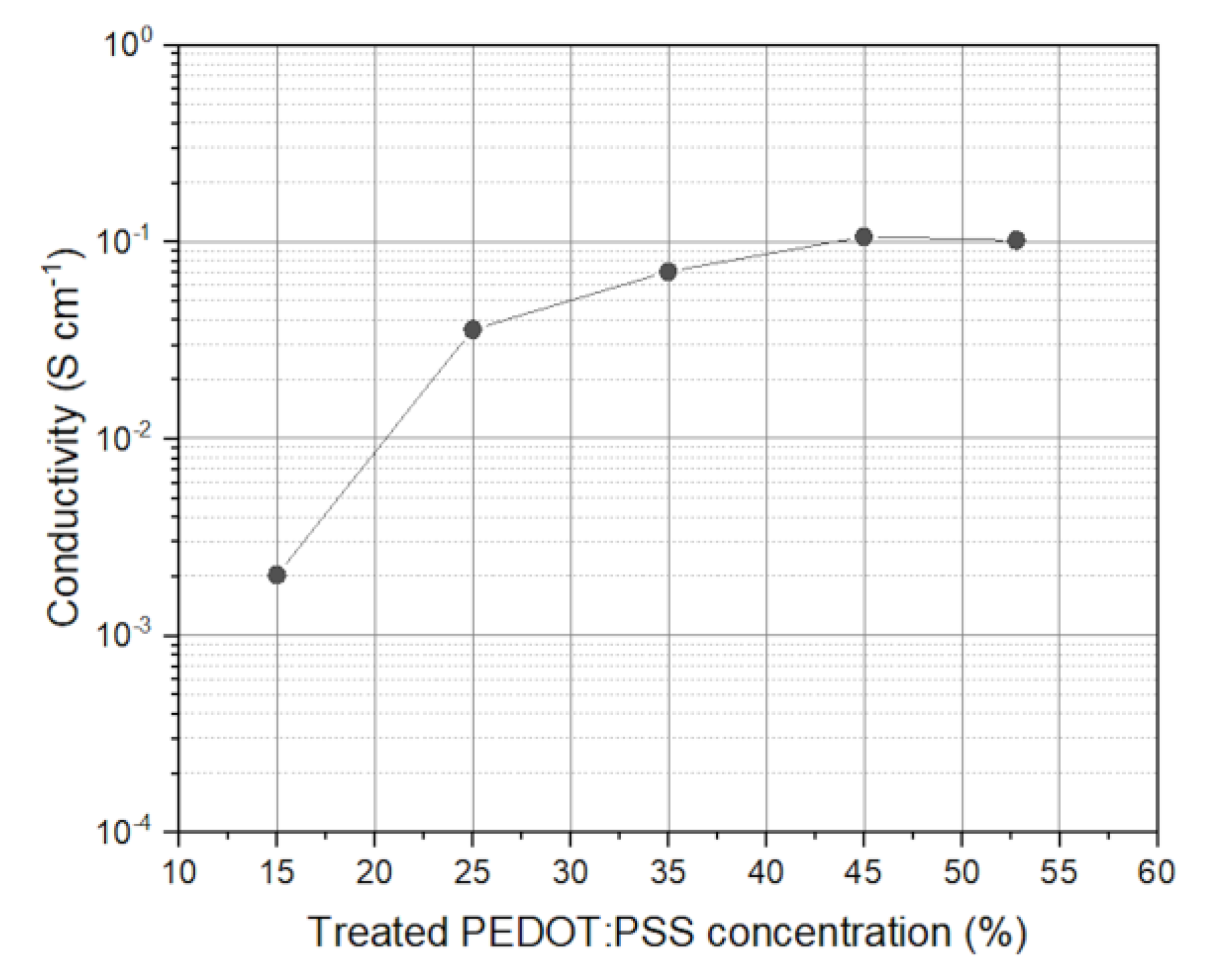
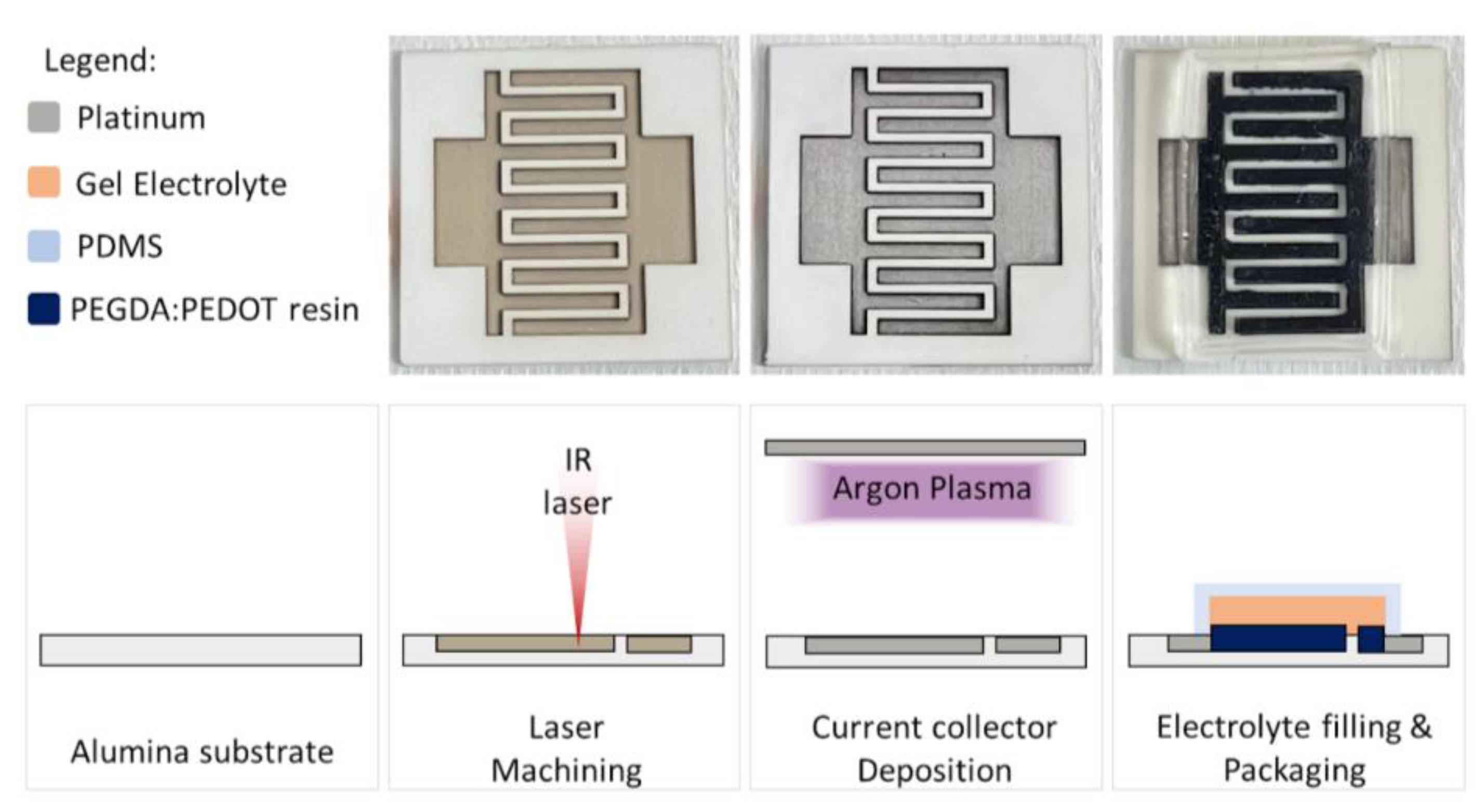
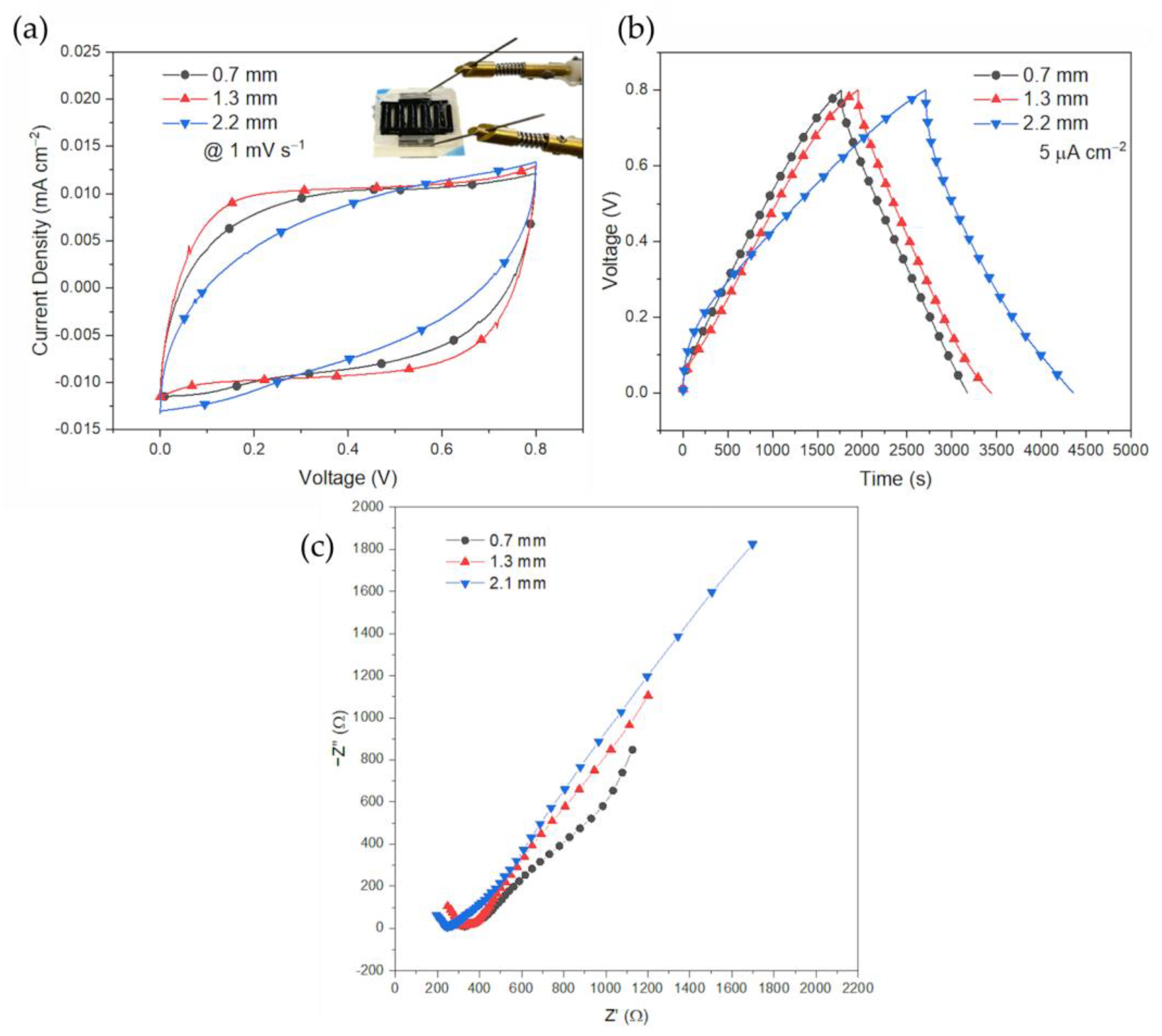
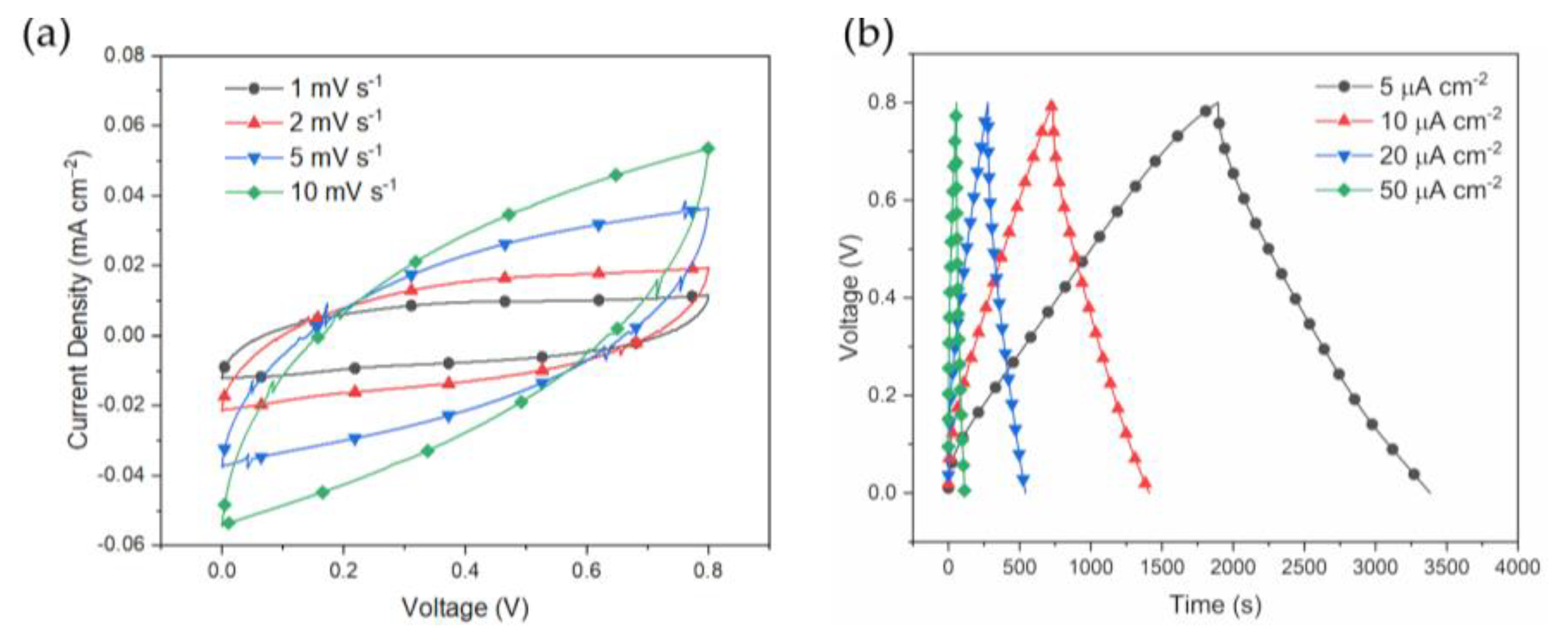
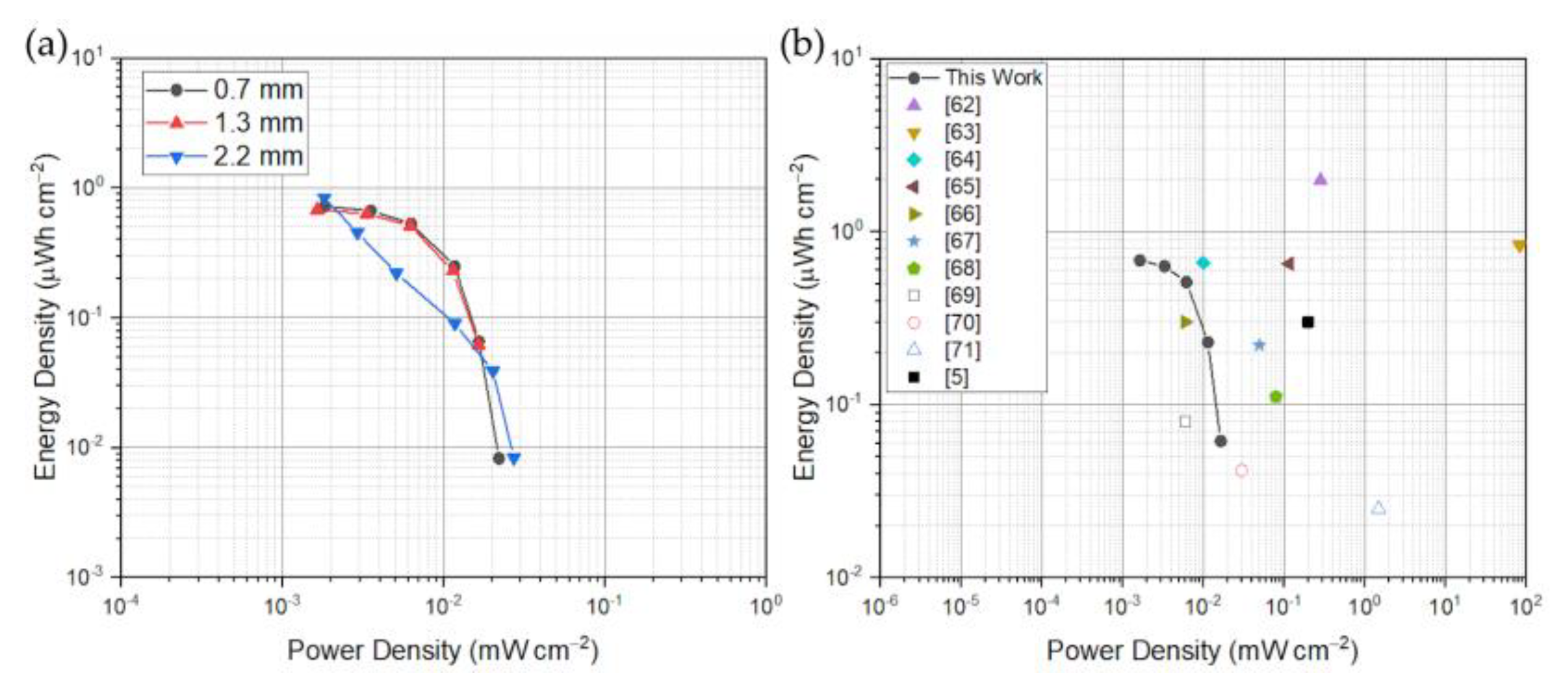

Disclaimer/Publisher’s Note: The statements, opinions and data contained in all publications are solely those of the individual author(s) and contributor(s) and not of MDPI and/or the editor(s). MDPI and/or the editor(s) disclaim responsibility for any injury to people or property resulting from any ideas, methods, instructions or products referred to in the content. |
© 2023 by the authors. Licensee MDPI, Basel, Switzerland. This article is an open access article distributed under the terms and conditions of the Creative Commons Attribution (CC BY) license (https://creativecommons.org/licenses/by/4.0/).
Share and Cite
Bertana, V.; Scordo, G.; Camilli, E.; Ge, L.; Zaccagnini, P.; Lamberti, A.; Marasso, S.L.; Scaltrito, L. 3D Printed Supercapacitor Exploiting PEDOT-Based Resin and Polymer Gel Electrolyte. Polymers 2023, 15, 2657. https://doi.org/10.3390/polym15122657
Bertana V, Scordo G, Camilli E, Ge L, Zaccagnini P, Lamberti A, Marasso SL, Scaltrito L. 3D Printed Supercapacitor Exploiting PEDOT-Based Resin and Polymer Gel Electrolyte. Polymers. 2023; 15(12):2657. https://doi.org/10.3390/polym15122657
Chicago/Turabian StyleBertana, Valentina, Giorgio Scordo, Elena Camilli, Limeng Ge, Pietro Zaccagnini, Andrea Lamberti, Simone Luigi Marasso, and Luciano Scaltrito. 2023. "3D Printed Supercapacitor Exploiting PEDOT-Based Resin and Polymer Gel Electrolyte" Polymers 15, no. 12: 2657. https://doi.org/10.3390/polym15122657
APA StyleBertana, V., Scordo, G., Camilli, E., Ge, L., Zaccagnini, P., Lamberti, A., Marasso, S. L., & Scaltrito, L. (2023). 3D Printed Supercapacitor Exploiting PEDOT-Based Resin and Polymer Gel Electrolyte. Polymers, 15(12), 2657. https://doi.org/10.3390/polym15122657










